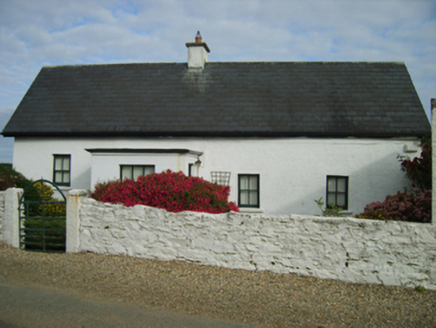Survey Data
Reg No
15704557
Rating
Regional
Categories of Special Interest
Architectural, Social
Original Use
House
In Use As
House
Date
1700 - 1840
Coordinates
282838, 107505
Date Recorded
06/09/2007
Date Updated
--/--/--
Description
Detached four-bay single-storey lobby entry house with dormer attic, extant 1840, on a rectangular plan off-centred on single-bay single-storey flat-roofed projecting porch. "Improved", pre-1902, producing present composition. Renovated, ----, to accommodate continued occasional use. For sale, 2010. Replacement pitched artificial slate roof with lichen-covered ridge tiles centred on cement rendered chimney stack having concrete capping supporting terracotta pot, rooflights to rear (north) pitch, and uPVC rainwater goods on timber eaves boards. Limewashed fine roughcast battered wall to front (south) elevation; limewashed lime rendered surface finish (remainder). Square-headed off-central door opening into house. Square-headed window openings with concrete or rendered sills, and concealed dressings framing two-over-two timber sash windows with six-over-three timber sash windows to gables to side elevations having part exposed sash boxes; one-over-one or two-over-two timber sash windows to rear (north) elevation. Set back from line of road with limewashed monolithic piers to perimeter supporting flat iron gate.
Appraisal
A house identified as an integral component of the vernacular heritage of south County Wexford by such attributes as the compact rectilinear lobby entry plan form; the construction in unrefined local materials displaying a battered silhouette with a flaking surface finish revealing evidence of "daub" or mud; the somewhat disproportionate bias of solid to void in the massing; and the high pitched roof originally showing a thatch finish according to an entry in the "House and Building Return" Form of the National Census (NA 1901; NA 1911). Having been well maintained, the elementary form and massing survive intact together with quantities of the historic or original fabric, both to the exterior and to the interior, thus upholding much of the character or integrity of the composition. Furthermore, adjacent "tin roofed" outbuildings (extant 1902) continue to contribute positively to the group and setting values of a neat self-contained ensemble making a pleasing visual statement in a rural street scene.

